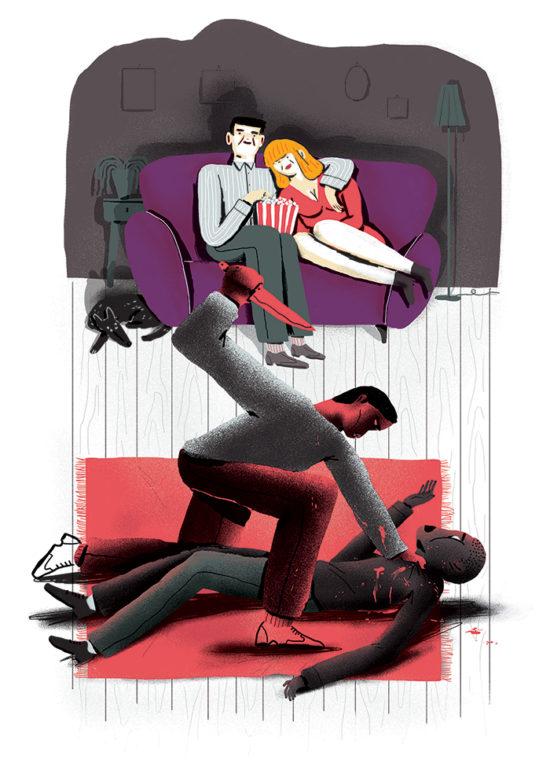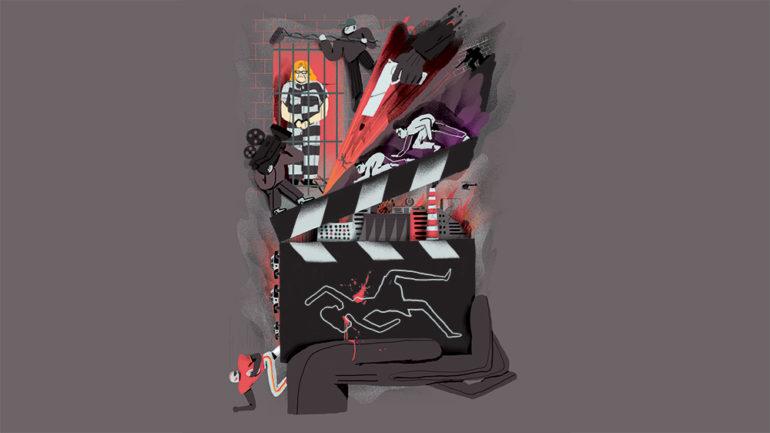Inside the True-Crime Boom Taking Over Prestige TV
By Daniel D’Addario
LOS ANGELES (Variety.com) – In 2016, the first season of Ryan Murphy’s “American Crime Story,” about the arrest and trial of O.J. Simpson, swept the Emmys’ limited-series categories, sparking a revival in mainstream interest in both the Simpson case and the true-crime genre. Ever since then, crime stories — American and otherwise — have been multiplying. It’s a boom that’s turning this year’s Emmy race into a digest of recent history.
Connie Britton was a Golden Globe nominee for Bravo’s “Dirty John,” adapted from a Los Angeles Times story and podcast about one woman’s encounter with a devious criminal. Patricia Arquette earned Globe and SAG honors for her role as a real-life prison employee who assisted in a breakout in Showtime’s “Escape at Dannemora.” Making her a possible double Emmy nominee for roles taken luridly from life, Arquette currently plays a mother eventually killed by the daughter she torments in Hulu’s “The Act.”
By the time “Chernobyl” — an HBO miniseries depicting the flailing response to the 1986 Ukrainian nuclear meltdown — hits screens May 6, viewers will have gotten a varied diet of shows that all do a similar thing. Despite changes in location and tone (“” is unapologetically soapy, while “Chernobyl” wears its prestige proudly) these programs share the task of excavating a notable story and examining details so seemingly outlandish that they could not have been invented. “I’ve never read a story with more frustrating behavior, countered with the most sacrificial behavior imaginable,” says Craig Mazin, who wrote “Chernobyl.” “It’s the best and worst of people.” Alexandra Cunningham, showrunner of “Dirty John,” echoes the thought: “The sources of greatest conflict are always what is going to give you the best drama, and crime is showing people at extremes.”
This genre — closed-ended stories that feature humanity’s lows and highs — will likely continue to grow. Familiar cases satisfy audience appetite for real-world stories in an era in which the hunger for reality has grown sharper. (The boom in fictionalizations mirrors a similar one in true-crime documentary, with entries including “Lorena” and the two seasons of “Making a Murderer.”) Michael Tolkin, co-showrunner of “Escape at Dannemora,” says that the programs slake the desire for the truth. “We live in a time of such lying. You know that when you’re dealing with true crime you’re illustrating some aspect of social reality. People are drawn to something that explodes the world that they live in.”
Tolkin’s partner, Brett Johnson, says “Escape at Dannemora” isn’t, at heart, about the escape at all. “Here was a prison-break story that was really about a woman. Anybody could watch and go, well, f–k, I’m in a town I don’t like or a marriage I don’t like or a job I don’t like.” The truest thing true crime may do is provide audiences access to the worst of human behavior, and help them understand their own dark impulses.
Michelle Dean, the co-showrunner of “” — based on a viral story she wrote for BuzzFeed in 2016 about the murder of Dee Dee Blanchard by her daughter, Gypsy Rose — doesn’t think interest in true crime is anything new. “Look back over 200 years of print history, and you’re going to see a lot of newspapers focusing on crime. We all know the ‘If it bleeds, it leads’ imperative.” What’s new is what Dean calls “respectability.” Before “Serial,” the 2014 podcast sensation that looks into the case of convicted murderer Adnan Syed, true crime was associated with down-market newsmagazine brands like “Dateline” or made-for-TV movies like Drew Barrymore’s “The Amy Fisher Story.” “Serial,” all philosophical musings and psychological portraiture, built an audience that might have otherwise avoided the genre.
And the true-crime shows battling for Emmys hew far more rigorously to the facts than had entertainments in the genre. “The Act” had a journalist leading the production. “Because we weren’t able to speak to Gypsy or the family, having Michelle there as a writer was extremely valuable,” says Nick Antosca, Dean’s co-showrunner. “Any time any of the writers had a question, we had somebody with direct experience writing the show.”
Other shows followed equally stringent guidelines. “Anything in there that deviates in some microscopic way from reality was all inspired by true stuff,” Johnson says of “Escape at Dannemora.” Cunningham also was in contact with her subjects. “At no point was I secretly thinking, ‘I could really milk this for salaciousness,’” she says. “I really wanted to be responsible for all of them and to not try to branch out into things they hadn’t already talked about.”
Where license must be taken, it’s done with care. Mazin is releasing a podcast summarizing the changes he made to the true story of Chernobyl, “to be accountable for it,” he says. “We don’t have to pretend everything we do in narrative representation of the truth is the truth. It’s not possible.” For all the research that creators put in, there will always be disputes: Tilly Mitchell, the woman played by Arquette in “Escape at Dannemora,” has contested the series, and Gypsy Rose Blanchard, the young woman (played by Joey King) at the heart of “The Act,” has threatened to sue over its depiction of her experiences. While Dean says all stories use some creative license, “the question is, are you doing it with a responsibility to the emotional truth of the story? Do you feel responsible to illustrate something about human nature or the crime? We did feel that responsibility, and that guided us.”
The race to mainstream acceptability isn’t the only trend at play in making the crime story TV’s current dominant form. There is also the rise of the limited series, as content providers seek more — and more varied — inventory. Showtime had been focused solely on open-ended series before 2017’s “Twin Peaks: The Return” and 2018’s “Patrick Melrose.” “We definitely prefer to have an audience fall in love with characters and have them come back year after year,” says Gary Levine, Showtime’s co-president of entertainment. “But we are building a varied portfolio of programming. We celebrate the range of shows we offer people.” And “Dirty John” was an unusually ambitious scripted undertaking for Bravo, giving a story of a woman first victimized and then empowered access to that channel’s rich vein of female viewers. Cunningham, who is at work on Season 2 of “Dirty John” (examining a new case of “true crime meets love gone wrong,” in her telling), says, “I think people were a little surprised by that at first, and I was surprised by their surprise!”
The rise of limited series has made true crime appealing to executives, providing compelling IP for networks looking for material that will connect with a fragmented audience. It also provides a perfect form for a genre that doesn’t work for features or episodic television. Mazin says he was “just a strongly obsessed hobbyist” reading about the Chernobyl disaster before “Fargo” and “True Detective” (both of which aired first seasons in early 2014, some months before the launch of “Serial”). “It never occurred to me to dare pitching this as a movie. It would ruin it,” he says. With limited series, “you have total format freedom.”
“The sources of greatest conflict are always what is going to give you the best drama, and crime is showing people at extremes.”
Alexandra Cunningham
That freedom includes being able to spread out details over multiple episodes and to build suspense over time. “The Act” wrings almost unbearable tension from the fact that its protagonist, Gypsy, has been told obvious lies about her health and could actually escape her mother. Dean notes that many producers she spoke to before partnering with Universal Content Prods. had wanted to create a story with a big narrative turn, not creeping unease. “I wasn’t interested in the third-act twist,” she says. “I was interested in how did these people get to where they were. And a whydunit is much better suited to a miniseries than a feature.”
Similarly, “Dannemora” presents its prisoners (Benicio Del Toro and Paul Dano) as sympathetic — until their escape. “We don’t do true-crime stories as a rule,” says Levine. “What attracted us to ‘Dannemora’ was its subversiveness. Yes, it’s a true-crime story, but you don’t see any violence for the first few episodes. You just meet this really weird triangle of three characters in this prison. And it’s a long way into the series before you actually get a taste of how brutally violent two of those three are.” While the show itself was sourced in fact, the late reveal of the pair’s cruelty was meant to amp up emotion. Says Johnson, “To put the moment they are the most sympathetic in the entire series right next to the worst moment of their entire life — you could never do that in a movie. You wouldn’t have time to do that in a movie.”
It isn’t just time that sets these projects apart — it’s also daring. TV is the only medium, perhaps, capacious enough to carry these visions in all their truthful oddity. It’s perfect for an era in which the truth seems unbelievable, and unbelievably complex. “Stories about the good guy and the bad guy sometimes don’t resonate with me,” says Johnson. “I don’t know that the good guy and the bad guy really does it right now.”


